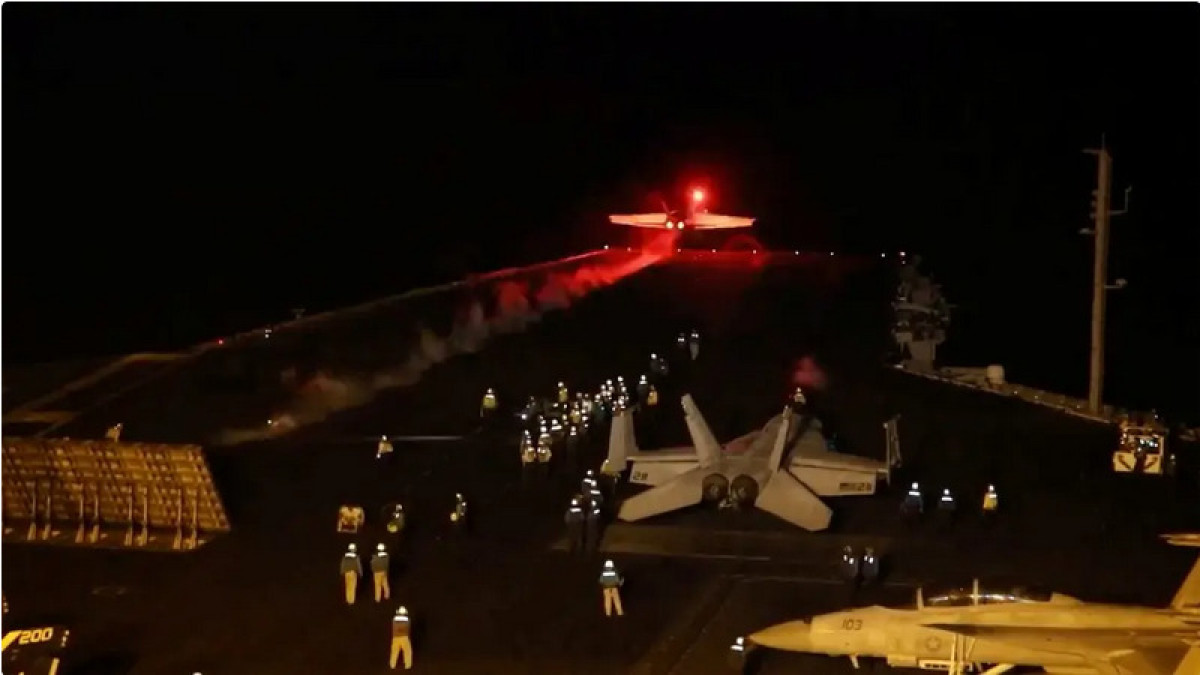Calculations Behind Washington's Military Operations Against Houthi Militia
- 15 Jan 2024


The military strikes launched by the United States and Britain against the locations of the Houthi "Ansar Allah" movement in five Yemeni governorates—Sana'a, Al Hudaydah, Taiz, Saada, and Hajjah—on January 12, 2024, were not only anticipated by observers but also expected by the Yemeni militia and all parties involved in the escalating situation in the Red Sea region.
These strikes were foreshadowed by multiple announcements from the United States and Britain, signalling the imminent implementation of military actions. Notably, the tour conducted by US Secretary of State Antony Blinken in the Middle East, which ended just one day prior to the initiation of these strikes, focused prominently on the Yemeni crisis. This occurred despite the pressing urgency of other significant matters, such as the ongoing Israeli war in the Gaza Strip and the escalating tensions between Israel and pro-Iranian militias across Arab nations, including Iraq, Syria, Lebanon, and Yemen.
Indeed, the renewed strikes, persisting into the following days and potentially extending in the coming days, have paved the way for various outcomes. This includes the potential escalation in the Red Sea region or the initiation of an open conflict between Israel and the United States on one side and Iran and affiliated militias on the other.
Several Implications
The military strikes carried out by the United States and Britain against the Houthi "Ansar Allah" militia hold several implications, shedding light on Washington's strategic calculations in the broader "open" conflict within the Middle East. Key considerations involve the locations of various parties engaged in the region. These several implications encompass:
In contrast to the substantial number of attacks, the restrained casualties indicate the Houthi militia's preparedness for the strikes. They swiftly executed a redeployment of their members, safeguarding concealed military capabilities. It's plausible that the administration of US President Joe Biden sought to convey indirect messages to the militia, forewarning them of the impending strikes to mitigate significant human losses among their ranks.
In essence, this signifies the US administration's deliberate effort to avoid provoking the militia to the point of eliciting a response. More precisely, the aim was to refrain from cornering the militia into a singular option—responding to the operations. Washington's primary objective is to deter the militia, halting its ongoing attacks in the Red Sea without necessitating further strikes in the subsequent phase. This approach becomes particularly significant as the United States gears up for presidential elections scheduled for November 5.
This observation suggests that President Joe Biden's administration's assertions to justify the recent military strikes might not align with the on-the-ground realities. The data indicate that Washington refrained from military action against the Houthi militia until the latter initiated targeting specific American interests in the region.
The incident on December 31 appears to underscore this point. Washington refrained from employing the military option against the Houthi militia until the militia's boats targeted US helicopters attempting to respond to a distress call from a Maersk ship under attack by these boats. The US Department of Defence sought to justify the military response by framing it within the context of "self-defence."
It is precisely within this framework that the recent military actions by the United States and Britain find an explanation. This move distinctly falls under the self-defence clause, particularly as it unfolded just two days following a Houthi militia attack characterised by the two nations as "complex." The militia deployed 18 drones, two cruise missiles, and a ballistic missile in the said attack.
Examining the United States' responses to developments in other regional crises reveals a consistent approach. On January 4, US forces conducted a military strike targeting the headquarters of the Iraqi "Al-Nujaba" militia, resulting in the death of its prominent leader, Mushtaq Al-Saeedi, known as "Abu Taqwa," along with other members. The US Department of Defence confirmed Al-Saeedi's involvement in recent attacks on US bases in Iraq and Syria.
In its entirety, this does not negate the possibility that the US military action was a response to the threats posed to global trade movement through the Red Sea. Houthi attacks compelled over 2,000 ships to divert from the Bab al-Mandeb Strait, opting for alternative routes, as highlighted by statements from the US delegate to the Security Council, Linda Thomas-Greenfield. However, this suggests that the trade disruption was not the sole reason and perhaps not the primary motive for this military intervention.
Notably, Iran swiftly withdrew the "Behshad" spy ship from the Red Sea on the same day the strikes commenced. This particular ship had been implicated in numerous reports for providing the "Ansar Allah" militia with information on the identity and destination of vessels transiting the Bab al-Mandeb Strait. Concurrently, during the tour led by US Secretary of State Antony Blinken in the region preceding the attacks, Iranian media emphasised the reception of several US messages in Tehran. This was further substantiated by US President Joe Biden on January 13, confirming that "the United States delivered a message specifically to Iran regarding the Houthis.
Additionally, UN Security Council Resolution No. 2722, issued on January 10 before the attacks, explicitly condemned the Houthi assaults and urged the militia to cease such actions. The resolution indirectly implicated Iran as a supporting party to the Houthis.
In this context, the approach adopted by the United States toward the current escalation in the Red Sea holds significant relevance. Through these strikes, Washington aims to exert pressure on the Ansar Allah movement, discouraging it from persisting in attacks within the Red Sea. Simultaneously, there is a concerted effort to prevent the current escalation from widening, whether through the movement's potential response to these strikes—a possibility not to be ruled out considering its past reactions to similar incidents and its launch of a ballistic missile towards a commercial ship after an initial strike—or by provoking Iran. Such provocation could lead Iran to instruct its agents to retaliate against US, British, and Israeli interests, whether in the Red Sea or any other region where these agents are present or where their military capabilities can reach.
Two main variables
Considering this, it can be asserted that the current US and British military escalation trajectory in Yemen hinges on two fundamental variables. Firstly, it will be influenced by the anticipated response from the Houthi militia. The course of action adopted by Washington and London will be shaped accordingly. Statements from key militia leaders imply that they may seek to escalate the costs of these operations by persisting in their attacks on the Red Sea.
Secondly, the trajectory of the current US and British military escalation in Yemen is contingent on Iran's calculations concerning the extension of the conflict. Iran remains committed to controlling the extent of its agents' involvement in the escalation against the United States and Israel. This determination is closely tied to its reluctance to broaden the scope of the ongoing escalation or directly engage in it.
Nevertheless, the sustained military attacks by Israel against Houthi leaders in their spheres of influence, coupled with the potential resumption of security and intelligence operations within Iran's borders targeting nuclear and military installations, along with an escalation in American pressure on Iranian agents, could prompt a reassessment of these calculations. Iran and its agents may recognise that the United States of America may have limited options at the present stage, particularly with the impending date of the US presidential elections scheduled for November 5.
The stated views express the views of the author and do not necessarily reflect the views of the Center or the work team.
Comments